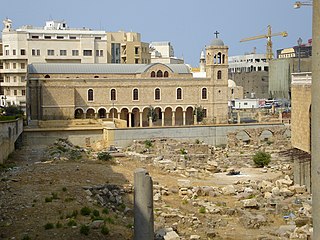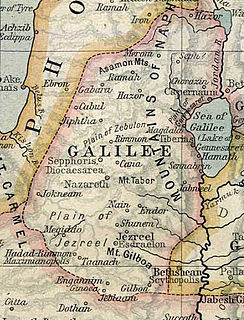Related Research Articles

Libanius was a Greek teacher of rhetoric of the Sophist school. During the rise of Christian hegemony in the later Roman Empire, he remained unconverted and in religious matters was a pagan Hellene.

Coele-Syria alternatively Coelo-Syria or Coelosyria, was a region of Syria in classical antiquity. It probably derived from the Aramaic word for all of the region of Syria, but it was most often applied to the Beqaa Valley between the Lebanon and the Anti-Lebanon mountain ranges. The area is now part of the modern-day Syria and Lebanon.
The droit d'auteur developed in the 18th century at the same time as copyright developed in the United Kingdom. Based on the "right of the author" instead of on "copyright", its philosophy and terminology are different from those used in copyright law in common law jurisdictions. It has been very influential in the development of copyright laws in other civil law jurisdictions, and in the development of international copyright law such as the Berne Convention.
The Apostles Fast, also called the Fast of the Holy Apostles, the Fast of Peter and Paul, or sometimes St. Peter's Fast, is a fast observed by Eastern Orthodox, Oriental Orthodox, Eastern Catholic, and Reformed Orthodox Christians. In the Byzantine tradition, the Fast begins on the second Monday after Pentecost, whereas in the Coptic and old Syriac traditions, the Fast begins on the first Monday after Pentecost. It continues until the Feast of Saints Peter and Paul on June 29. Traditionally, its duration varies from eight to forty-two days because of the moveable nature of Pascha (Easter). However, in Eastern Orthodox Churches that follow the Revised Julian calendar, the fast can be as long as 29 days, or may not occur at all in some years.

Berytus, briefly known as Laodicea in Phoenicia or Laodicea in Canaan from the 2nd century to 64 BCE, was the ancient city of Beirut from the Hellenistic period through the Roman and Early Byzantine period/late antiquity. The city had been rebuilt by the Seleucids in the 2nd century BCE over the ruins of an older settlement centred on a Phoenician port dating back to Iron Age III and Persian periods. Berytus became a Roman colonia that would be the center of Roman presence in the eastern Mediterranean shores south of Anatolia. The veterans of two Roman legions under Augustus were established in the city, that afterward quickly became Romanized and was the only fully Latin-speaking city in the Syria-Phoenicia region until the fourth century. Although Berytus was an important city, Tyre was made the capital of the Roman province of Phoenicia. "Of the great law schools of Rome, Constantinople, and Berytus", the law school of Berytus stood "pre-eminent". The Code of Justinian was mostly created in this school.
The land of Phoenicia was ruled by the Neo-Babylonian Empire from around 605 BC to 538 BC.

Ptolemais was an ancient port city on the Phoenician coast. It was also called Ptolemais in Phoenicia. It was an Ancient bishopric, which became a double Catholic titular see.

Phoenicia was an ancient Semitic-speaking thalassocratic civilization that originated in the Levant region of the eastern Mediterranean, primarily modern Lebanon. It was concentrated along the coast of Lebanon and included some coastal areas of modern Syria and Galilee, reaching as far north as Arwad and as far south as Acre and possibly Gaza. At its height between 1100 and 200 BC, Phoenician civilization spread across the Mediterranean, from Cyprus to the Iberian Peninsula.
Gaianus was the Patriarch of Alexandria for three months in 535.
Flavius Eusebius was a Roman Senator, who was the brother-in-law of the emperor Constantius II.
Seleucus also known as Flavius Seleucus and Count Seleucus was a wealthy Greek rhetor who was a close friend of Libanius and the Roman emperor Julian the Apostate.
Calliopius was a Greek rhetor and official of the Roman Empire.

The law school of Berytus was a center for the study of Roman law in classical antiquity located in Berytus. It flourished under the patronage of the Roman emperors and functioned as the Roman Empire's preeminent center of jurisprudence until its destruction in AD 551.
(Flavius) Hermogenes was a Roman senator who served in various civilian offices from the reign of Licinius through to Constantius II.
Patricius (Patrikios) was a fifth-century Roman jurist who taught in the ancient Law School of Berytus. Patricius was of the seven revered "Ecumenical Masters" and occupied the position of Quaestor of the Sacred Palace in the East, a senior legal office in the late Roman Empire, from the middle to the late fifth century.
Philippe Malaurie was a French professor of private law.

Marcel Planiol was a French professor of law at the University of Rennes, then at the Sorbonne. He wrote on the law and on historical Brittany. He is known for his Elementary Treatise of Civil Law (1901), which attempted to explain French civil law in terms of elementary principles, particularly the maxims of Roman law.
Belesys was a satrap of Syria for the Achaemenid Empire in the 4th century BCE.